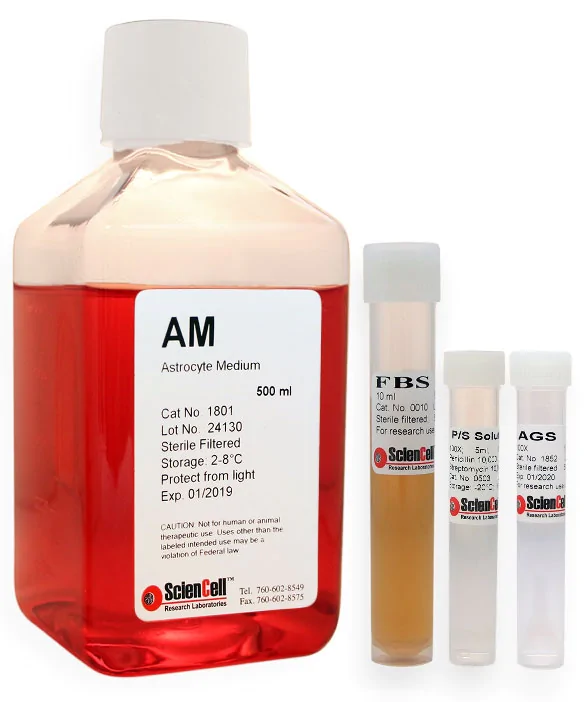Astrocyte Medium
Product Code:
SC-1801
SC-1801
Host Type:
Human
Human
Regulatory Status:
RUO
RUO
Shipping:
Dry Ice
Dry Ice
No additional charges, what you see is what you pay! *
| Code | Size | Price |
|---|
| SC-1801 | 500 ml | £156.00 |
Quantity:
Prices exclude any Taxes / VAT
Stay in control of your spending. These prices have no additional charges to UK mainland customers, not even shipping!
* Rare exceptions are clearly labelled (only 0.14% of items!).
* Rare exceptions are clearly labelled (only 0.14% of items!).
Multibuy discounts available! Contact us to find what you can save.
This product comes from: United States.
Typical lead time: 10-14 working days.
Contact us for more accurate information.
Typical lead time: 10-14 working days.
Contact us for more accurate information.
- Further Information
- Documents
- References
- Related Products
- Show All
Further Information
Description:
Astrocyte Medium (AM), when used with Astrocyte Growth Supplement (AGS, Cat #1852) and 10 ml of fetal bovine serum (FBS) is a complete medium designed for optimal growth of normal astrocytes in vitro. It is a sterile, liquid medium which contains essential and non-essential amino acids, vitamins, organic and inorganic compounds, hormones, growth factors, trace minerals and a low concentration of fetal bovine serum (2%). The medium is HEPES and bicarbonate buffered and has a pH of 7.4 when equilibrated in an incubator with an atmosphere of 5% CO2/95% air. The medium is formulated (quantitatively and qualitatively) to provide an optimally balanced nutritional environment that selectively supports the growth of normal astrocytes in vitro.
Extra Description:
AM consists of 500 ml of basal medium, 10 ml of fetal bovine serum (FBS, Cat. No. 0010), 5 ml of astrocyte growth supplement (AGS, Cat. No. 1852) and 5 ml of penicillin/streptomycin solution (P/S, Cat. No. 0503).
Documents
References
- https://journals.plos.org/plosone/article?id=10.1371/journal.pone.0062241
- https://journals.plos.org/plosone/article?id=10.1371/journal.pone.0065936
- https://www.oncotarget.com/article/604/text/
- https://www.ncbi.nlm.nih.gov/pmc/articles/PMC3890698/
- https://pubmed.ncbi.nlm.nih.gov/21057530/
- https://molecularbrain.biomedcentral.com/articles/10.1186/s13041-015-0138-6
- https://journals.plos.org/plosone/article?id=10.1371/journal.pone.0150360
- http://www.ncbi.nlm.nih.gov/pmc/articles/PMC4428755/pdf/nihms687563.pdf
- http://www.ncbi.nlm.nih.gov/pmc/articles/PMC4594676/pdf/jcmm0019-2341.pdf
- https://pubmed.ncbi.nlm.nih.gov/26751456/
- https://www.ncbi.nlm.nih.gov/pmc/articles/PMC4627295/
- https://journals.plos.org/plosone/article?id=10.1371/journal.pone.0143112
- http://www.ncbi.nlm.nih.gov/pmc/articles/PMC4673998/pdf/cam40004-1705.pdf
- http://f1000researchdata.s3.amazonaws.com/manuscripts/8385/e8b1f021-7282-484d-b88e-4850c6d7b33c_7142_-_david_male_v2.pdf
- http://download.springer.com/static/pdf/916/art%253A10.1186%252Fs12974-015-0374-9.pdf?originUrl=http%3A%2F%2Fhttp%3A%2F%2Fjneuroinflammation.biomedcentral.com%2Farticle%2F10.1186%2Fs12974-015-0374-9&t
- http://download.springer.com/static/pdf/109/art%253A10.1186%252Fs1297401607251.pdf?originUrl=http%3A%2F%2Fjneuroinflammation.biomedcentral.com%2Farticle%2F10.1186%2Fs1297401607251&token2=exp=147586484
- https://jneuroinflammation.biomedcentral.com/articles/10.1186/s12974-016-0659-7
- http://download.springer.com/static/pdf/460/art%253A10.1186%252Fs1293501603399.pdf?originUrl=http%3A%2F%2Fcancerci.biomedcentral.com%2Farticle%2F10.1186%2Fs1293501603399&token2=exp=1475864988~acl=%2Fs
- https://www.ncbi.nlm.nih.gov/pubmed/29738614



